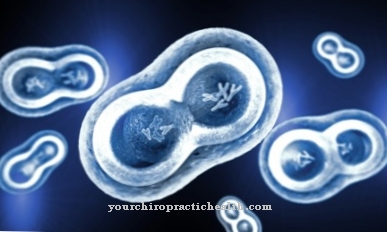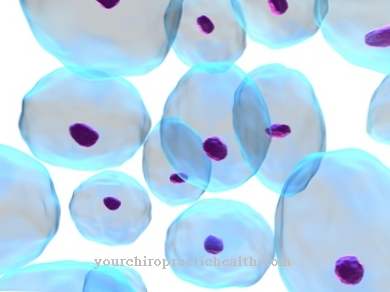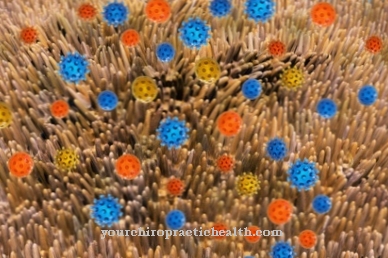As Dentinogenesis denotes the formation of the dentin. Dentin is also called dentin. It is a product of the odontoblasts.
What is dentinogenesis?

During dentinogenesis, the dentin of the teeth is formed. A large part of every tooth is made of dentin. The substance is also called dentin or substantia eburnea. In contrast to tooth enamel, dentin can be formed anew for a lifetime.
Dentin resembles bone in its composition. It consists of around 70 percent calcium hydroxylapatite. This in turn is largely formed from phosphate and calcium. 20 percent of the components of dentin are organic. 90% of them are collagens. 10% of the organic content consists of water.
The dentin is yellowish in color. On the one hand, the tooth enamel and, on the other hand, the root cement lies on the dentin. The tooth pulp with blood vessels, connective tissue, nerves and lymph vessels is tightly enclosed and protected by the dentin.
Function & task
Dentin is formed by the odontoblasts. Odontoblasts are cells with a mesenchymal origin. They sit at the transition from the tooth pulp to the dentine. The cells are arranged cylindrically and are able to form dentin for life. As a result, the space for the pulp becomes smaller and smaller in the course of life. This is the reason why teeth are less sensitive with age.
Dentin is divided into primary dentin, secondary dentin and tertiary dentin. Primary dentin is produced during tooth formation. The structurally similar secondary dentin is reproduced for life. The tertiary dentine is also known as irritant dentine. In contrast to primary and secondary dentin, it is not formed evenly in the tooth, but only when there is an external stimulus. The tertiary dentine serves to protect the pulp from external stimuli.
The primary dentin is formed before the enamel. The odontoblasts produce uncalcified predentin at their tip. By depositing hydroxyapatite crystals, this predentine mineralises and thus becomes dentine. The odontoblasts form fine tubules within the dentin. These dentinal tubules run centrifugally outward from the pulp. There they then reach the dentine-enamel boundary.
Processes of the odontoblasts protrude through the dentinal tubules. These Tomes fibers are in close contact with free nerve endings. Along with the fibers, also unmarked nerve fibers run through the dentin. These nerve fibers mediate toothache in tooth decay.
While primary dentine and secondary dentine are very similar in their structure, the histology of tertiary dentine shows a different picture. Tertiary or protective dentine is an expression of a defense reaction. Such a defense reaction of the body can be, for example, thermal stimuli or bacterial infections. The most common cause is tooth decay. In contrast to the primary and secondary dentine, the protective dentine has a fibrin-like structure. It also has significantly fewer tubules. Tertiary dentine is also formed when the enamel shrinks and exposes the underlying dentine.
The deposition of the less sensitive irritant dentine can prevent wear and tear of the more sensitive underlying dentine, at least for a certain period of time.
You can find your medication here
➔ Toothache medicationIllnesses & ailments
Dentin formation is impaired in the case of Dentinogenesis imperfecta (DGI). It is a hereditary disease that is inherited as an autosomal dominant trait. The cause of this genetic disorder is a mutation in the DSPP gene. The DSPP gene coordinates the proteins that are involved in dentin formation. The result is impaired dentin formation, which leads to an abnormal dentin structure and thus also to abnormal tooth development.
Characteristic symptoms of dentinogenesis imperfecta are worn teeth, bulging tooth crowns, a narrowing of the tooth necks as well as destroyed tooth pulp chambers and destroyed root canals. The dentin is amber or even opalescent.
Dentinogenesis is also disturbed in dentinal dysplasia. The disease can be divided into a radicular form (type 1) and a coronal form (type 2). Like Dentinogenesis imperfecta, both forms are inherited as an autosomal dominant trait. Patients suffering from dentine dysplasia 1 show so-called apical lightening. The teeth are free from tooth decay and are usually normal in color. Diseased teeth often show abnormal mobility. However, most people do not notice the disease. In the X-ray image, however, you can see enlarged cavities within the dentin. The therapy depends on the respective complaints. Endodontological or endosurgical procedures can be used to preserve the teeth. If the teeth can no longer be preserved, an implantation can be carried out after the teeth have been removed.
Type 2 dentinal dysplasia is a mild form of the disease. It is rather rare and shows abnormal deciduous teeth in normal tooth roots.Amber discoloration is visible in the primary dentition. It can also lead to bulging tooth crowns and faster wear of the teeth. The neck of the tooth is narrowed. Artificial crowns can be placed on the molars to prevent the deciduous teeth from wearing out. These are usually made of stainless steel.
The later permanent set of teeth is usually not affected by the disorder. At most, there are slight anomalies in the X-ray image. The pulp cavities may be bell-funnel-shaped. One speaks here of "thistle tubes". Multiple calcifications of the tooth pulp are also observed. However, those affected are usually symptom-free.
























.jpg)



